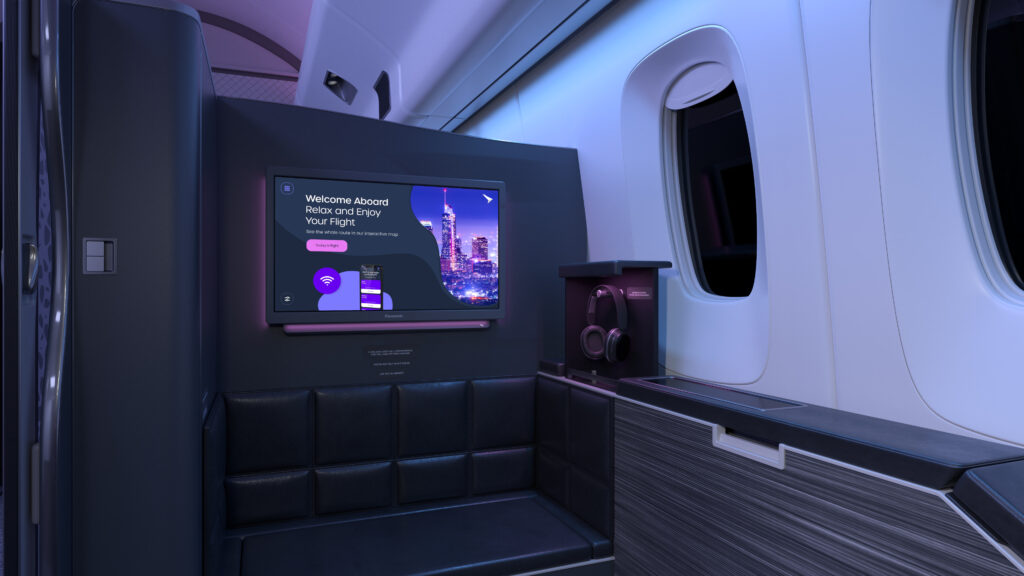Bigger, Brighter, Better: In-Flight Entertainment Screens Get a High-Tech Makeover
In-flight entertainment systems are catching up with TV tech as airlines introduce better screens, improved picture quality, USB-C charging, and Bluetooth capabilities
by John Walton
August 9, 2023

Photo: SAFRAN Rave in-flight entertainment. Courtesy of SAFRAN
If you’ve been struggling to understand the different types of TV technologies available for your home, such as LED, mini LED, OLED, QLED, high dynamic range, and more, then you may not be surprised to hear that these technologies are now being introduced to airplanes as well, and sooner than you might think.
For your seat, that means better picture quality, blacker blacks, brighter colors, more clarity, more power to charge your personal electronic devices, and Bluetooth headphone capabilities.
Bigger, brighter screens for first and business
One of the odd things about the structure of airline seats, especially in business and first class, is that sometimes you may end up with a lower quality overall entertainment experience than if you were in a premium economy.

Photo: Thales Optic IFE. Courtesy of Thales
It’s all a function of viewing distance: in a premium economy seat with a 15.6” inflight entertainment screen, your head will be just 30-35” from the screen. In a First Class suite, with a wall-mounted screen at the foot of your bed, you’ll be about 78” away, so even the biggest screens will feel much smaller.
To improve in-flight entertainment, Panasonic Avionics now offers screens in first and business class that range in size from 19” to 42”. For comparison, most business class seats are around 22” wide, and the largest iMac available today is 24”.
Better picture quality with new technologies
Big screens are all very well, but what’s the picture quality? Well, better than ever. Technologies like OLED, QLED, mini-LED, and high dynamic range are all arriving in your seat, which means brighter brights, darker darks, blacker blacks, and faster refresh.

Photo: Panasonic Astrova IFE. Courtesy of Panasonic
New screens are also more reliable — and, even in business class, are hot-swappable, which means that your seat inflight entertainment system will no longer stay out of service for a flight or two before maintenance can fix it.
Now, the systems can be exchanged for a replacement using a simple tool, like what you do when you connect a laptop to a dock. The replacement is often carried on the aircraft, either installed behind the last row of seats or in a clever storage area.
More power and more upgradeability for the future
If screen technology has dragged behind what travelers want and need, in-seat power has dragged even further. Part of the problem is that the now-vintage slow-charging USB-A sockets (that’s the slowest version of the old square USBs) were hard-installed onto the seat, making upgrading particularly complicated since some seats from the mid-2000s are still flying today, even on the best airlines.
Today, it’s all about delivering high power — up to 100W — over USB-C (the new oval-shaped USBs). That’s enough to fast-charge anything, even up to the largest laptops.
Even better, this often comes from quick-swap upgradeable sections, like Panasonic’s Astrova peripheral bar, which is recessed underneath the screen and houses options like audio jacks, Bluetooth, and USB power.

Photo: Panasonic Astrova IFE. Courtesy of Panasonic
Most airlines are still installing the rectangular USB-A and oval USB-C connectors alongside each other, but it’s been some years since modern smartphones used USB-A, so pretty soon, we’ll start to see only USB-C being installed.
All this means that it’s easier to swap out the upgradeable sections, either because someone has broken the USB connector (more common than you might think) or because we have a new USB connector or something entirely different ten years down the line.



